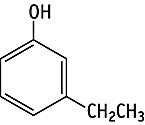

In a 28-day repeat dose toxicity test, the following behavior indicative of toxicity was observed in males and females given 1000 mg/kg; adoption of a lateral and/or prone position, staggering gait and soiling of perigenital fur. Males given 1000 mg/kg had decreased body weights and food consumption on Days 2 and 7. Males and females given 1000 mg/kg demonstrated increased water consumption and urine volume. Males and females given 1000 mg/kg had increased GPT, and females increased total cholesterol. Males and females given 1000 mg/kg demonstrated increase in liver weights with or without elevation in relative weights, and males increase in renal relative weights. Males and females given 1000 mg/kg showed hyperplasia of squamous cells in the forestomach. This change seemed to be caused by irritating effects of 3-ethylphenol. The NOELs are considered to be 300 mg/kg/day for males and females.
A reverse mutation test of 3-ethylphenol in bacteria was carried out. This substance was not mutagenic in Salmonella typhimurium TA100, TA1535, TA98, TA1537 and Escherichia coli WP2 uvrA, with or without an exogenous metabolic activation system.
Genotoxicity of 3-ethylphenol was studied by the chromosomal aberration test using cultured Chinese hamster lung (CHL/IU) cells.
3-Ethylphenol induced structural chromosomal aberrations at all three doses (0.050-0.20 mg/mL) tested with short-term treatment and metabolic activation.
| Purity | : | 96.2 % |
| Test species/strain | : | Rat/Crj:CD(SD)IGS |
| Test method | : | OECD Test Guideline 401 |
| Route | : | Oral(Gavage) |
| Doses | : | 0(Vehicle), 1000, 1200, 1450, 1700, 2000 mg/kg |
| Number of animals/group | : | Males, 5; Females, 5 |
| Vehicle | : | Olive oil |
| GLP | : | Yes |
Test results:
The LD50 values were estimated to be 1709 mg/kg for males and 1691 mg/kg for females.
| Purity | : | 96.2 % |
| Test species/strain | : | Rat/Crj:CD(SD)IGS |
| Test method | : | Guideline for 28-Day Repeated Dose Toxicity Test in Mammalian Species (Chemical Substances Control Law of Japan) |
| Route | : | Oral(Gavage) |
| Doses | : | 0(Vehicle), 100, 300, 1000 mg/kg/day |
| Number of animals/group | : | Males and females, 14, 7, 7 and 14/group for 0, 100, 300 and 1000 mg/kg, respectively |
| Vehicle | : | Olive oil |
| Administration period | : | Males and females, 28 days |
| Terminal kill | : | Days 29 and 43 |
| GLP | : | Yes |
Test results:
| Purity | : | 96.2 % |
| Test species/strains | : | Salmonella typhimurium TA100, TA1535, TA98, TA1537, Escherichia coli WP2 uvrA |
| Test method | : | Guidelines for Screening Mutagenicity Testing of Chemicals(Chemical Substances Control Law of Japan) and OECD Test Guideline 471 |
| Procedures | : | Pre-incubation method |
| Solvent | : | Dimethyl sulfoxide |
| Positive controls | : | -S9 mix; 2-(2-Furyl)-3-(5-nitro-2-furyl)acrylamide (TA100, TA98, WP2 uvrA), Sodium azide (TA1535) and 9-Aminoacridine (TA1537) +S9 mix; 2-Aminoanthracene (five strains) |
| Doses | : | -S9 mix; 0, 62.5, 125, 250, 500, 1000, 2000 μg/plate(five strains) +S9 mix; 0, 62.5, 125, 250, 500, 1000, 2000 μg/plate(five strains) |
| S9 | : | Rat liver, induced with phenobarbital and 5,6-benzoflavon |
| Plates/test | : | 3(1 for cytotoxicity test) |
| Number of replicates | : | 2(plus 1 cytotoxicity test) |
| GLP | : | Yes |
Test results:
Genetic effects:
Salmonella typhimurium TA100, TA1535, TA98, TA1537
| + | ? | - | |
| Without metabolic activation: | [ ] | [ ] | [*] |
| With metabolic activation: | [ ] | [ ] | [*] |
Escherichia coli WP2 uvrA
| + | ? | - | |
| Without metabolic activation: | [ ] | [ ] | [*] |
| With metabolic activation: | [ ] | [ ] | [*] |
| Purity | : | 96.2 % |
| Type of cell used | : | Chinese hamster lung (CHL/IU) cells |
| Test method | : | Guidelines for Screening Mutagenicity Testing of Chemicals(Chemical Substances Control Law of Japan) and OECD Test Guideline 473 |
| Solvent | : | Dimethyl sulfoxide |
| Positive controls | : | -S9 mix; Mitomycin C +S9 mix; Cyclophosphamide |
| Doses | : | -S9 mix(short-term treatment); 0, 0.063, 0.13, 0.25 mg/mL +S9 mix(short-term treatment);0, 0.050, 0.10, 0.20 mg/mL -S9 mix(continuous treatment for 24 hr); 0, 0.025, 0.050, 0.10 mg/mL |
| S9 | : | Rat liver, induced with phenobarbital and 5,6-benzoflavone |
| Plates/test | : | 2 |
| GLP | : | Yes |
Test results:
| Lowest concentration producing cytogenetic effects in vitro: | ||
| With metabolic activation (short-term treatment) | : | 0.050 mg/mL (clastogenicity) |
Genotoxic effects:
| clastogenicity | polyploidy | |||||
| + | ? | - | + | ? | - | |
| Without metabolic activation: | [ ] | [ ] | [*] | [ ] | [ ] | [*] |
| With metabolic activation: | [*] | [ ] | [ ] | [ ] | [ ] | [*] |
| 1) | The tests were performed by the Safety Research Institute for Chemical Compounds Co., Ltd., 363-24 Shin-ei, Kiyota-ku, Sapporo, Hokkaido, 004-0839, Japan. Tel +81-11-885-5031 Fax +81-11-885-5313 |
| 2) | The tests were performed by the Hatano Research Institute, Food and Drug Safety Center, 729-5 Ochiai, Hadano-shi, Kanagawa, 257-8523, Japan. Tel +81-463-82-4751 Fax +81-463-82-9627 |